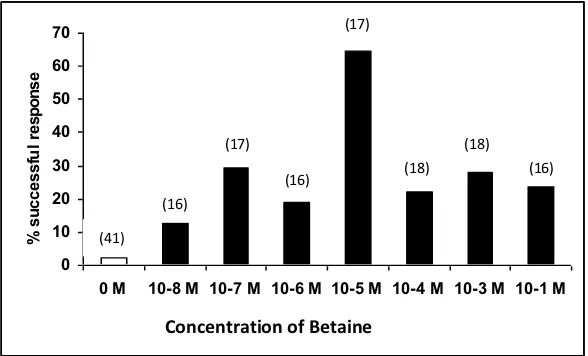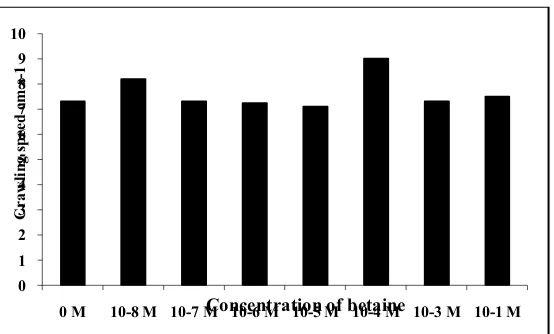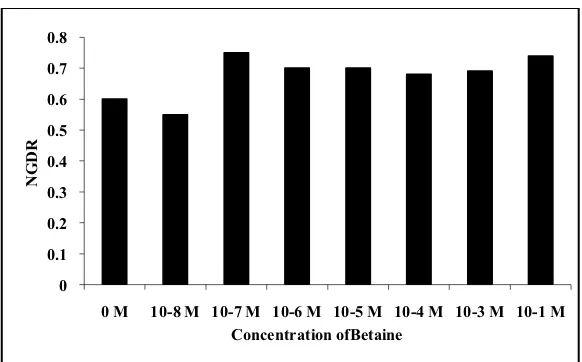Response of North Pacific Seastar
A. Amurensis
To Food Attractant (Betaine)*)
DENY SUHERNAWAN YUSUP
Department of Biology Faculty of Math and Natural Science University of Udayana
Email: dsyusup@yahoo.com
INSTISARI
Penelitian tentang respon hewan bintang laut Pacific Utara telah dilakukan di Tasmania Aquaculture and Fisheries Institute (TAFI) Taroona Hobart Tasmania. Tujuan penelitian ini untuk mengetahui respon
Asterias amurensis terhadap stimulant (asam amino Betaine) dan ambang konsentrasi yang direspon serta orientasi pemangsaan (NGDR dan kecepatan merayap). Tujuh konsentrasi (Molar) larutan Batine yang ditandai pewarna rhodamine digunakan dalam penelitian ini yaitu: 0 M (kontrol), 10-1 M; 10-3 M; 10-4 M; 10-5 M; 10-6 M; 10-7 M; 10-8 M. Kecepatan arus yang digunakan adalah 1.1 cm/dt. Respon di rekam dengan video kamera dan dianaliasa dengan program MOCHA. Hasil analisa statistik
menunjukkan bahwa respon maksimum ditunjukkan pada konsentrasi 10-5 M (P: 0.05, IDF= 3.843). Kosentrasi ambang diduga antara 10-7 M and 10-8 M. Hasil penelitian juga menunjukkan bahwa tidak ada perbedaan respon bintang laut kecil dengan yang besar. Hasil analisa statistik juga menunjukkan bahwa NGDR dan keceparan merayap tidak ada perbedaan diantara konsentrasi Betaine.
Kata kunci: Chemosensory, Asterias amurensis, Perilaku makan, Foraging, Sensitivitas
ABSTRACT
A study on the response of North Pacific Sea star was undertaken at Tasmania Aquaculture and Fisheries Institute (TAFI) Taroona Hobart Tasmania. The objectives o the observation wer to observe response of Asteria amurensis to various of feeding attractant (Bbetaine-amino acid) concentration, the threshold concentration to which A amurensis respond; feeding orientation (NGDR) and crawling spped. Seven molars concentration of feeding attractant dyed with rhodamine were applied i.e. 0 M (control), 10-1 M; 10-3 M; 10-4 M; 10-5 M; 10-6 M; 10-7 M; 10-8 M.. The experiment was carried out in a simulation tank with unidirectional flow i.e. 1.1 cm/s. Feeding response was recorded with video camera and quantitatively analyzed by means of image analysis software i.e. MOCHA. The statistical analysis results indicate that the maximum response was shown at 10-5 M (P: 0.05), IDF= 3.843) and the threshold concentration was thought at between 10-7 M and 10-8 . It was also shown that there was not significant difference on the response of small and large size individuals, except at 10-1M concentration. The were no significant difference on both NGDR and crawling speed.
INTRODUCTION
The marine environment is crowded with a variety of molecules at various concentrations, resulting from processes occurred in the water and in or on the seabed. These molecules could act as stimulant for the activities of many animals. In the aquatic environment, the optimization of foraging by those creatures relying on an olfactory sensory organ, which could be correlated with the ability to sense distant food qualitatively and quantitatively from the cues received (Zimmer-Faust, 1987). Foragers living in an aquatic habitat should be able to distinguish the alteration occurred in a particular substance from the background chemical mixture diluted in the water. Such ability is related to energy gained, where the energy obtained is determined by the sensitivity of a forager to such changes in orienting and locating the resources.
demonstrated that a mixture of amino acids was nearly as effective as extract of prey, however when tested alone, the amino acids had only a modest stimulatory capacity. Further investigations of seastar responses to feeding attractants are needed.
The present study used betaine, an amino acid commonly found in fish, crabs, and molluscs as a feeding attractant. It has been demonstrated that betaine is able to elicit a feeding response in the seastar Luidia clathrata (McClintock et al., 1984). The amino acid has also been used in a study of the feeding behaviour of other carnivores such as in Palaemonetes pugio (Carr, 1978) and Macrobrachium rosenbergii (Harpaz and Steiner, 1990).
The aims of this study were to investigate whether Asterias amurensis would be able to locate prey on the surface by tracking an odour plume of betaine solution, and the threshold sensitivity of A. amurensis
to this amino acid.
MATERIALS AND METHODS
RESULTS
Threshold Concentration
The response of seastars to molar concentration of betaine solution is presented in Fig.1. The responses resulted in a bell-shaped graph with 10-5 M producing the maximum response. The proportion of successful seastars increased from 2.44 % ; in the control to a peak of 58.82% in 10-5M but changed only slightly from 10-4 to 10- 1.
The low response of of seastars to molar concentration of betaine solution in controls indicated that the seastars were not attracted to rhodamine solution, nor to water flow alone. Moreover, the low responses to high molar concentrations suggest that the betaine becomes a repellant at these levels.
Fig 1. The response of A. amurensis to Betaine solution (flow rate 1.1. cm s-1). The number in the brackets indicates the number of seastar in each trial
The Chi-square analysis indicates that the control (0 M) was significantly different from all concentrations except 10-8 M, while 10-8 was not significantly different from 10-7 M This indicated that the threshold concentration, i.e. the minimum, betaine concentration needed for eliciting feeding behaviour, was between 10-8 M and 10-1 M. The effect of size on response of A. amurensis is presented
in Fig. 2. No small seastars were successful in the control and 10-1 M. A chi-square analysis indicated that the only significant difference between small and large was at 10-1M (P= 0.0147)
Feeding Orientation
Crawling speed and NGDR of A. amurensis in response to these betaine concentrations are presented in Figs 3 and 4. Statistical analysis by means of two tailed t-tests (unequal replication) indicated that the crawling speed was not significantly different between concentrations (P > 0.05) except between 10-5 and 10-4 M. There was also non significantly different NGDRs at these concentrations (P > 0.05).
DISCUSSION
Many aquatic organisms rely on waterborne chemical cues and incoming flow to detect their prey using their sensory organs, discriminating food sources and identifying their enemies. As organisms with poorly developed visual sense, seastars has also been demonstrated to rely heavily on waterborne chemical cues. It is thought that seastars are able to interpret the cues for their foraging in particular, though there are conflicting conclusions in the literature about such capability. Conflict may arise because the responses are species specific (Sloan, 1980), or may be because seastars are also responding to such physical factors applied in those studies (Moore and Lepper, 1997).
Fig. 2. The response of small and large Asterias amurensis to different molar concentration of Betaine solution (flow rate 1.1. cm s-1).
The present study shows convincingly that A.amurensis is capable of responding to a chemical cue released in the water column, and also is able to locate the source of the cue by tracking the odour plume.
Fig. 3. Crawling speed of A. amurensis to different molar concentration of Betaine solution (flow rate 1.1. cm s-1).
Fig. 4. NGDR of A. amurensis to different molar concentration of Betaine solution (flow rate 1.1. cm s-1).
The findings of the current study agree with the results of a laboratory study conducted by Moore and Lepper (1990) that demonstrating that Asterias forbesi was capable of responding to the presence of an odor, and also be able to locate the odour source in still water. Chemosensitivity responses of A. amurensis in the present study are consistent with the study by Lockhart (1995) on prey preference in flowing water by means of a Y-maze. If the flow velocity applied in Lockhart's study i.e. water discharge 3 1 min-1 is converted to mean velocity as used in the present study by calculating the size of the tank, the flow was equal to 0.25 cm s-1 which is fairly similar to the flow applied in the present study (1.1 cm s-1). The results of Lockhart's study showed the capability of A. amurensis to locate the prey provided in the arms of the maze though they chose the prey inconsistently. Therefore it is unlikely the response was to water current alone. This agrees with the present finding that those seastars tested in the control tank did not show a rheotactic response.
capability in tracking the plume under multi-directional flow conditions.
Aquatic predators with poor visual sense rely on information .detected in waterborne plumes. It is known that stimulation of the feeding response will only occur when odor concentration in the water column exceeds the threshold concentration for perception by their sensory organs (Jones 1992, cited in Hara, 1992).
The results of the present study indicated that the response of A. amurensis to chemical cue is concentration related. Response to different betaine concentrations was bell-shaped; the responses increased with increasing concentration only up to some apparent optimal level, and then decreased as the concentration further increased. The low response in low concentration may be because the cue was too weak to elicit a feeding response or it was too low to be detected by the seastar. In contrast, the low response shown to the high concentration may be because high concentrations act as a repellent to the sensory organs of the seastar. A physiological explanation for the bell-shaped response phenomenon is lacking
Similar results have been reported by Carr (1978) for Palaemonetes pugio. It is suggested that response increases as the odour concentration increases. Such results, however, do not entirely agree with the present results and another study on seastars (McClintock and Lawrence, 1986) which describes the response as increasing as the odour concentration increases, but reaching a plateau even though the odour concentration increased. McClintock and Lawrence (1986) found a similar result from a study on fish.
The response-concentration relationship indicates the threshold concentration of betaine to which A. amurensis responded. The threshold is between 10-7 and 10-8 M. Such a high sensitivity enables
source through the odour plume formed. Such sensitivity helps to compensate for their limitation of movement when they are searching for prey. Further it implies the potential of A. amurensis as a very dangerous predator that could influence benthic faunal community structure. This is highlighted by their ability to dig up to 10 cm (adult individual) depth in sediments. Therefore A. amurensis could have massive impact on benthic faunal communities in a given habitat.
The threshold concentration to which seastars are attracted seems to be influenced by many factors such as type of substance, and or physiological state i.e. satiation level. The study by Valentincin (1985) on Marthasterias glacialis demonstrated various behavioural thresholds of the seastar for some effective feeding stimuli such as L-proline, cysteine and acetylcholine iodide. Thresholds may be related to differences in chemical configuration of each amino acid and differences in site attachment at the sensory organ. It likely that such differences could result in different responses from the organism. Similarly, such substance-specific threshold responses have also been demonstrated for other aquatic species such as the seastar, Luidia clathrata (McClintock et al., 1984), shrimp, Palaemonetes Pugio
(Carr, 1978) and fishes, genus Savelinus (Harra, 1992)
Another factor that should be taken into account in determining threshold concentration is satiation level. It is thought that the threshold concentration decreases as hunger level increases. A study on sablefish (Anoploma fimbria) demonstrated that the reduction of food supplies significantly increases the sensitivity of the fish to dissolved free amino acids in squid extract. However it remains unclear how such a change in physiological state could increase the sensitivity of sensory organs.
The concentration-response showed that 10-5 M betaine resulted in maximum response.
This finding agrees with a previous study on the tubefeet response of Asterias amurensis to
different molar concentration applied by means of a cotton bud dosed with betaine (pers. obs). It
10-5 M betaine solution. Though betaine has been recognised as a potent amino acid eliciting
feeding behaviour in many aquatic organisms including seastars, in the current study betaine
could only motivate modest responses of A. amurensis. Such modest stimulatory capacity of a
solution of betaine alone was also shown in the study by Carr (1978) on Palaemonetes pugio.
But Carr (1978) also demonstrated that a mixture of amino acids was nearly.as effective as an
extract of intact prey such as sea urchin, oyster and blue crab. Another study on Lobster
(Homarus gammarus) found that amino acids, either as single compounds or in combination,
were less attractive than food extract (Lockhart, 1995).
These studies indicated that arousal of a feeding response is a result of the collective
response of many sites in the sensory organ to different elicitor substances contained in a given
food source, and is not the result of a response to a single compound per se. Thus laboratory
responses to simple solutions are unlikely to be equivalent to the natural response under field
conditions. Though there is a difference in efficiency between single compounds and mixtures,
the use of mixtures of amino acids or prey extract could still mimic the synergistic and
suppressive interaction that could occur among individual substances, as suggested by
Zaimmer-Faut et al. (1984) and Carr and Derby (1986). The study by Zafiriou et al. (1972) demonstrated
such suppressive interaction. This study showed that the addition of particulates significantly
decreased the effectiveness of the stimulus. In contrast, a study by Carr et al. (1977) on pigfish
(Orthopristis chrysopterus) and Zaimmer-Faut et al. (1984) on P. pugio demonstrated a
synergistic interaction that increased the effectiveness of the amino acids involved.
correlation between pattern of movement (crawling speed and orientation) of A. amurensis and the concentrations of odour tested. It does not support the expectation that there is a positive correlation between concentration and the pattern of movement.
response, e.g. frequency and magnitude of change in direction of movement, once prey were encountered. The behavior resulted in an individual remaining in a high plume concentration. The study by Dalle (1997) on A. forbesi suggested that the seastars is alteration of stimulus concentration as measured at the tube feet in the tip of each arm to guide them to a food source. In other words the seastars would change their direction of movement to the previous track when faced with a weaker signal.
CONCLUSION
This study indicates that the maximum response of North Pacific Seastar was at 10-5 M and the threshold concentration was thought between 10-7 M and 10-8 M. This study also show that there were not different sensitivity between small and arge individual.
REFFERENCES
Beddingfield, S.D. and McClintock, J.B.. (1993). Feeding behavior of the seastar Astropecten articulatus (Echinodermata: Asteroidea) : An evaluation of energy-efficient foraging in a soft-bottom predator. Mar. Biol.. 115 (4) :669-676.
Carr, W.E.S. (1978). Chemoreception in shrimp, Palaemonetes pugio: the role of amino acids and betaine in elicitation of a feeding response by extracts. Comp. Biochem. Physiol.. 61A: 127-131.
Carr, W.E.S. and Derby, C. B. 1986. Behavioral chemoattractants for the shrimp, Paleomonetes pugio: identification of active compounds in food extract and evidence of synergistic mixture interaction. Chem, Senses. 11 : 49-64.
Carr, W.E.S., Blumenthal, K.M. and Netherthon 111, J.C. 1977. Chemoreception in the pigfish,
Orthopristis chrysopterus: the contribution of amino acids and betaine to stimulation of feeding behaviour by various extract. Comp. Biochem. Physiol.. 58A: 69-73.
CastillaJ.C. (1972). Response of Asterias rubens to bivalve prey in a Y-maze. Mar. Biol.. 12:222-228. Dalle, J. 1997. Chemosensory search behaviour in the starfish Asterias forbesi. Biol. Bull.. 193: 210-212. Hara, T. J., 1992. Mechanism of olfaction in Hara, T. J. (ed).Fish chemoreception. Chapman & Hall.
Melbourne. P: 372.
Macrobrachium rosenbergii (De Man 1879) (Decapoda, Caridae). Crustaceana. 58 (2): 175-185. Lockhart, S.J. 1995. Feeding biology of the introduced sea star Asterias. amitrensis. unpublished Honours
thesis. Dep. Zoology Univ. of Tasmania.
Mackie, A.M. and Shelton,R.G.J. 1972. A whole-animal bioassay the determination of the food atractants of the lobster, Homarus gammarus. Mar. Biol.. 14:217-221.
McClintock, J.B. and Lawrence, J.M. 1984. Ingestive conditioningin Luidia clathrata
(Echinodermata:Asteroidea): efect of nutrition condition on selectivity, teloreception and rates of ingestion. Mar. Behav. Physiol.. 10:167-181.
McClintock, J.B. and Lawrence, J.M. 1985. Characteristic of foraging in the softbottom benthic starfish Luidia clathrata (Echinodermata: Asteroidea): prey selectivity, switching behaviour, functional responses and movement patterns. Oecologia (Berlin). 66: 291-298,
McClintock, J.B., Klinger, T.S. and Lawrence, J.M. 1984. Chemoreception in Luidia clathrata
(Echinodermata: Asteroidea): qualitative and quantitative aspects of chernotactic responses to low molecular weight compounds. Mar. Biol.. 84: 47-52.
Moore, P.A. and Lepper, D.M.E. 1997. Role of chemical signal in the orientation behaviour of the seastar Asteriasforbesi. Biol. Bull.. 192: 410-417.
Oliver, J.S., Kvitek, R.G. and Slattery, P.N.. 1985. Walrus feeding disturbance: scavenging habits and recolonisation of bearing sea benthos. J, Exp. Mar, Biol. Ecol.. 91: 233-246.
Pearson, W.H., Sugarman, P.C., Woodruff,D.L. and 011a, B.L. 1979. Threshold for detection and feeding behavior in the dungeness crab, Cancer magister (Dana). 1. Exp. Mar. Biol. Ecol., 39:65-78. Rochette, R., Hamel, J-F. and Himmelman, J.H.. 1994. Foraging strategy of the asteroid Leptasterias
polaris: role of prey odour, current and feeding status. Mar. Ecol Prog. Ser.. 106: 93-100.
Sloan, N.A. 1980. Aspect of the feeding biology of Asteroids. Oceanogr. Mar. Biol. Ann. Rev.. 18.57-124. Valentincic , T. 1983. Innate and learned responses to external stimuli in asteroids. In Jangoux, M. and
Lawrence J.M. (eds) Echinoderm tudies, vol. 1. Balkema, Rotterdam.
Valentincic, T. 1985. Behavioral study of chemoreception in the seastar Marthasterias glacialis: structure-activity relationship of lactic acid, amino acid, and acetylcholine. J. Comp. Physiol.-A. 157: 537-545.
Weissburg, M.J. and Zimmer-Faust, R.K. 1994. Odor plumes and how blue crabs use them in finding prey. J. Exp. Biol.. 197: 349-375.
Zimmer-Faust, R.K.. 1987. Crustacean chemical perceptioan: toward a theory on optimal chemoreception. Biol.Bull.. 172: 10-29


